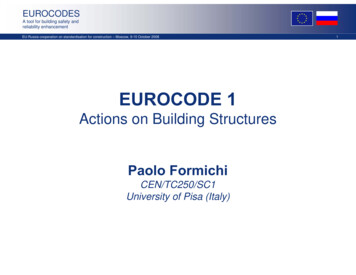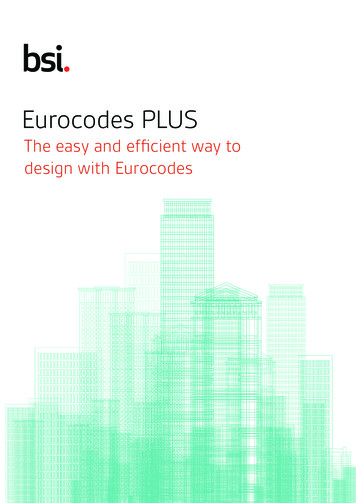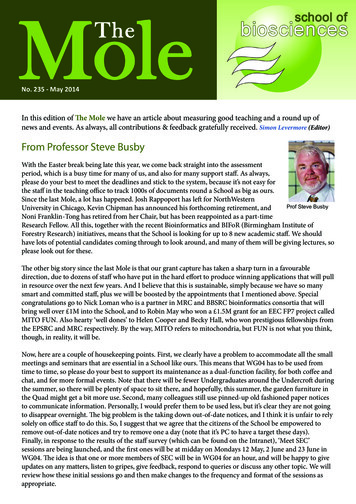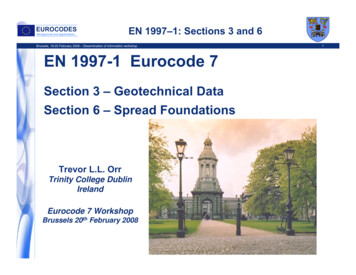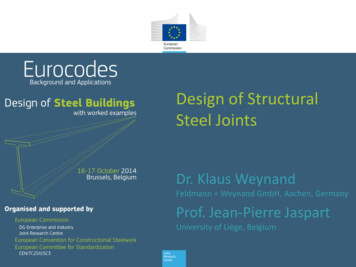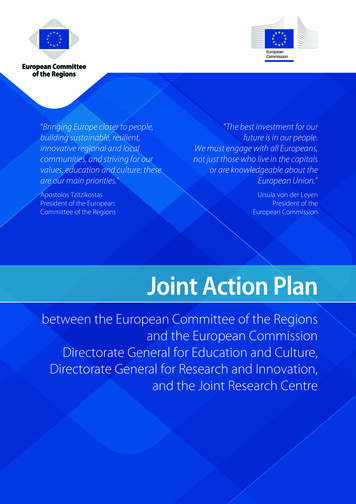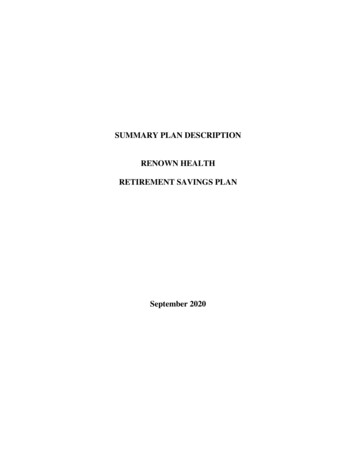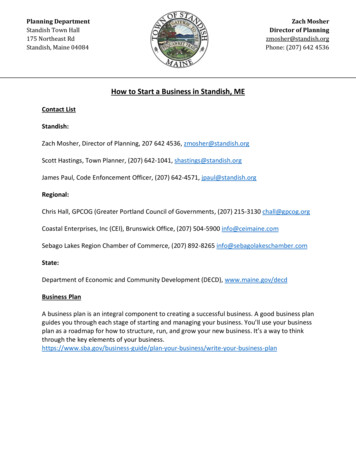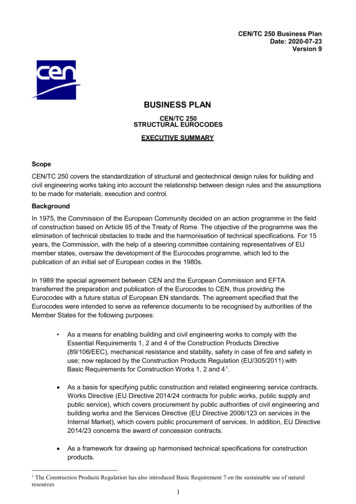
Transcription
CEN/TC 250 Business PlanDate: 2020-07-23Version 9BUSINESS PLANCEN/TC 250STRUCTURAL EUROCODESEXECUTIVE SUMMARYScopeCEN/TC 250 covers the standardization of structural and geotechnical design rules for building andcivil engineering works taking into account the relationship between design rules and the assumptionsto be made for materials, execution and control.BackgroundIn 1975, the Commission of the European Community decided on an action programme in the fieldof construction based on Article 95 of the Treaty of Rome. The objective of the programme was theelimination of technical obstacles to trade and the harmonisation of technical specifications. For 15years, the Commission, with the help of a steering committee containing representatives of EUmember states, oversaw the development of the Eurocodes programme, which led to thepublication of an initial set of European codes in the 1980s.In 1989 the special agreement between CEN and the European Commission and EFTAtransferred the preparation and publication of the Eurocodes to CEN, thus providing theEurocodes with a future status of European EN standards. The agreement specified that theEurocodes were intended to serve as reference documents to be recognised by authorities of theMember States for the following purposes: As a means for enabling building and civil engineering works to comply with theEssential Requirements 1, 2 and 4 of the Construction Products Directive(89/106/EEC), mechanical resistance and stability, safety in case of fire and safety inuse; now replaced by the Construction Products Regulation (EU/305/2011) withBasic Requirements for Construction Works 1, 2 and 4 1. As a basis for specifying public construction and related engineering service contracts.Works Directive (EU Directive 2014/24 contracts for public works, public supply andpublic service), which covers procurement by public authorities of civil engineering andbuilding works and the Services Directive (EU Directive 2006/123 on services in theInternal Market), which covers public procurement of services. In addition, EU Directive2014/23 concerns the award of concession contracts. As a framework for drawing up harmonised technical specifications for constructionproducts.The Construction Products Regulation has also introduced Basic Requirement 7 on the sustainable use of naturalresources11
CEN/TC 250 Business PlanDate: 2020-07-23Version 9The Structural Eurocodes were first available as European pre-standards (ENVs) and thenconverted to the full European standards (ENs). Publication of each of the various ENEurocode Parts started in 2002 and was complete in 2006, for adoption by the CEN members.Full implementation of this first generation of EN Eurocodes was scheduled for 2010.In May 2010, the European Commission (EC), Enterprise and Industry Directorate-General, sentthe Programming Mandate M/466 EN to CEN concerning the Structural Eurocodes. Thepurpose of this mandate was to initiate the process of further evolution of the Eurocode system,incorporating both new and revised Eurocodes.As the technical committee responsible for the preparation of European rules for structural andgeotechnical design (Structural Eurocodes), CEN/TC 250 prepared a reply to M/466 on behalf ofCEN that was issued to the Commission in June 2011. In December 2012, the EC, Enterpriseand Industry Directorate-General, sent a further Mandate M/515 EN, inviting CEN to develop adetailed standardisation work programme using the reply to mandate M/466 as a basis.In 2013, CEN/TC 250 developed a detailed work programme incorporating the requirements ofMandate M/515 EN. This work programme, which forms the focus for the future activities ofCEN/TC 250, comprises four overlapping phases and will lead to the publication of the secondgeneration of EN Eurocodes. However, CEN/TC 250 recognises the importance of stability forusers of the Eurocodes and these revised and extended standards are not expected to be publishedprior to 2020.In December 2015, the European Commission confirmed funding for Phase 1 of the CEN/TC 250work programme under Mandate M/515. In January 2017 and January 2018, the EuropeanCommission confirmed funding for Phase 2 and Phases 3 and 4 respectively. Through an opencall for experts, Project Teams were established to undertake the specific tasks in M/515 Phases1 to 4. Their work is on-going.BenefitsThe benefits of the Structural Eurocodes include: providing a common understanding regardingthe design of structures between owners, operators and users, designers, contractors andmanufacturers of construction products; facilitating the exchange of construction services betweenMember States; providing a common basis for research and development in the constructionsector; allowing the preparation of common design aids and software; and increasing thecompetitiveness of the European civil engineering firms, contractors, designers and productmanufacturers in their world-wide activities.2
CEN/TC 250 Business PlanDate: 2020-07-23Version 9PrioritiesThe current priorities for CEN/TC 250 include:(i) The successful delivery of the work programme developed in response to MandateM/515 EN.This work includes revisions to the existing codes to cover: improving the ease of use of the Eurocodes, particularly for day-to-day calculations, increased harmonisation through a reduction in National Determined Parameters, orconvergence of values used, aspects of the assessment, re-use and retrofitting of existing structures, strengthening of the requirements for robustness.The work programme includes the development of a new Structural Eurocode on Glass andthe treatment of atmospheric icing and actions from waves and currents on coastal structuresin the Eurocodes family, based on ISO Standards. It also includes steps towards thedevelopment of new Eurocodes on membrane structures and structural applications of FibreReinforced Polymers (FRP).Systematic reviews of all existing Eurocode parts are being undertaken. The results of thesereviews are being used to inform the development of the second generation of EN Eurocodes.(ii) Essential maintenance of the existing EurocodesSignificant maintenance to the existing EN Eurocodes (through the publication of newamendments) is not expected during the period while the development of the next generationof EN Eurocodes is being undertaken. However, C E N / TC 250 will respond to any emergentsafety issues through the publication of amendments to the existing Standards if necessary.(iii) Promotion of the Structural EurocodesCEN/TC 250 supports efforts of the European Commission to promote the use of theStructural Eurocodes, including promotion outside the member states of the EuropeanCommunity.1 . BUSINESS ENVIRONMENT OF THE CEN/TC 2501.1 Description of the Business EnvironmentThe 59 Structural Eurocodes parts produced by CEN/TC 250 provide rules for basis of design,actions on structures, geotechnical design as well as structural design rules for the use of all themajor materials i.e. concrete, steel, composite steel and concrete, timber, masonry, andaluminium. On that basis the design rules can be used for a majority of building and engineeringstructures utilizing the different materials covering also earthquake resistance.Note: CEN BT decision C54/2018 approved the request from CEN/TC 250 to withdraw EN 1993-4-3:2007Eurocode 3: Design of steel structures – Part 4-3: Pipelines as presented in CEN/TC 250 N 1932.3
CEN/TC 250 Business PlanDate: 2020-07-23Version 9Structural Eurocodes are equally applicable to whole structures and to individual elements ofstructures (products).Standardization in the structural design field across national boundaries enables a greater flow oftechnical expertise, information and products between countries and lead to greater cooperationand harmonization in the building and civil engineering market place particularly in the field ofdesign of whole structures (consulting engineers) and the design of structural elements (productmanufacturers) as well as in competitiveness and fairness of tendering - ‘the level playing field’.Political, economic, social, technical, legal and international factors that either directly requiresome or all of the standardization activities proposed by CEN/TC 250, or significantly influence theway these activities are carried out are the following: The relationship with the Construction Products Regulation (CPR) particularly BasicRequirement for Construction Works 1: Mechanical resistance and stability and BasicRequirement for Construction Works 2: Safety in case of fire and Basic Requirement forConstruction Works 4: Safety in use. The importance of the Structural Eurocodes is not only its relevance to structural designrules for buildings and civil engineering structures in the 33 CEN Members but also on theinternational scene. This work is closely monitored by CEN Members under ISO in order to minimizedifferences in their design practices and in order to achieve greater harmonizationbetween CEN and ISO Members. Greater ISO/CEN co-operation is foreseen.1.2 Quantitative Indicators of the Business EnvironmentThe construction industry is hugely significant to the European economy. It is generally acceptedthat it accounts for some 6-7 % of total European GDP and employs approaching 15 millionpeople.Analysis reported by the European Commission in impact assessment SEC (2008) 1900 hasidentified the total annual value of the European construction market as over 1,800 Billion, withdesign services making up 75 Billion.Furthermore, the use of the Eurocodes extends outside the European economy. The Standardsare currently being implemented by countries in Asia and Africa, and are being incorporated intodesign requirements used in Middle East. Dialogue is ongoing with Russia and interest has beenexpressed by many other countries around the world.2 BENEFITS EXPECTED FROM THE WORK OF THE CEN/TCStructural Eurocodes prepared by CEN/TC 250 enable Design Engineers to utilize harmonizeddesign rules for structures and hence assist in eliminating barriers to trade. The benefits andopportunities of adopting the Eurocodes include: provide a common understanding regarding the design of structures between owners,operators and users, designers, contractors and manufacturers of constructionproducts facilitate the exchange of construction services between countries facilitate the marketing and use of structural components and kits of parts in Member4
CEN/TC 250 Business PlanDate: 2020-07-23Version 9States a common basis for research and development in the construction sector allow the preparation of common design aids and software increase the competitiveness of the civil engineering firms, contractors, designers andproduct manufacturers in their world-wide activities.Furthermore, the intended impacts and associated benefits of the current CEN/TC 250 workprogramme for the development of the second generation of EN Eurocodes are summarized in thetable below:ImpactBenefitUser confidence inEurocodes retained as theyremain state-of-the-artdocumentsThis is an essential underpinning requirement for the Eurocodes toremain credible standards of the highest reputation, promotingconfidence in their use within Europe and adoption elsewhere aroundthe world. Increased user-friendliness in comparison with the firstgeneration of Eurocodes will reflect best practice in standardsdevelopment.Improved efficiency ofdesign processes andreduced barriers to entrythrough enhanced userfriendlinessImproved harmonizationacross member states,through e.g. reduction inNDPs and different designmethodsThe design market has an annual worth of 75 Billion. Every 0.1%efficiency saving in design processes would therefore yield a75 Million annual saving. Enhanced user friendliness will reducebarriers to entry and aid opportunities for small and medium sizedenterprises.Improved harmonization will reduce barriers to trade of products andservices.Use of new methods andnew materials. Enhancedcoverage of robustnessThis will enable the latest technologies and knowledge to be appliedin a way that is acceptable for practitioners, promoting costeffectiveness and sustainability in design, and innovation.Relevant sustainabilityconsideration incorporatedwithin design requirementsThis supports European Community objectives, including those forenergy saving and waste accrual.Climate changeconsideration embracedwithin EurocodesThis will provide increased resilience of long-life infrastructure assetsto potential climatic changes. It is very cost effective to address suchrisks at the design stage rather than through later retrofitting. Suchan approach also reduces user disruption and environmentalimpacts.Incorporation of initialrequirements forassessment and retrofitof existing structuresThis supports the effective and sustainable management of existinginfrastructure, providing a consistent technical framework acrossmember states as a platform for future R&D and appropriateharmonization, enabling the sustainable life extension of existingassets.5
CEN/TC 250 Business PlanDate: 2020-07-23Version 93 PARTICIPATION IN THE CEN/TCAll the CEN national members are entitled to nominate delegates to CEN Technical Committee, itseleven Subcommittees and experts to Working Groups, ensuring a balance of all interested parties.Participation as observers of recognized European or international organizations is also possibleunder certain conditions.Over recent years TC 250 Sub-committees (TC-SCs) and Working Groups (TC-WGs) haveestablished a complex structure of subordinate groups (sub-groups) to support them in their work.The latest CEN/TC 250 substructure list is available in the 01. Public information folder on Livelink.To participate in the activities of CEN/TC 250 and its subordinate groups, please contact the nationalstandards organization in your country.4 OBJECTIVES OF THE CEN/TC AND STRATEGIES FOR THEIR ACHIEVEMENT4.1 Defined objectives of the CEN/TCThe Structural Eurocodes programme was initiated by the European Commission with theobjective of establishing a set of common technical rules for the design of building and civilengineering works to ultimately replace the differing rules in force in the various Member States.This objective remains.Structural Eurocodes prepared by CEN/TC 250 enable Design Engineers to utilize harmonizeddesign rules for structures and hence assist in eliminating barriers to trade.For the Structural Eurocodes to remain world-class Standards, it is essential that they areperiodically revised to reflect changes to the state of the art, enhanced user-friendliness, latestinnovations and the needs of the market.In addition to the development and maintenance of the Eurocodes, CEN/TC 250 supports efforts ofthe European Commission to promote the use of the Structural Eurocodes, including promotionoutside the member states of the European Community.4.2 Identified strategies to achieve the CEN/TC’s defined objectives.In order to achieve its objectives, CEN/TC 250 operates 11 Sub-committees and 5 Working Groupsto cover all aspects of structural design with different materials and under different loading andenvironmental conditions. These Sub-committees (SCs) and Working Groups (WGs) are as followsin the figure 1 below.The Chairmen and Convenors and the Secretaries and Professional Standardization Supports ofthe SCs and WGs are spread across many of the CEN Members in order to achieve greaterco-operation and harmonization.CEN/TC 250 recognises the on-going essential relationship between Eurocodes and NationalRegulations and encourages the participation of regulators in its work and in continuous formaland informal consultation.6
CEN/TC 250 Business PlanDate: 2020-07-23Version 9Figure 1: CEN/TC 250 Organogram (July 2020)CEN/TC 250 also strongly recognizes its responsibilities to ensure consistency throughoutEurocodes in both technical and presentational aspects and the essential requirement tocommunicate and cooperate with other bodies in the construction industry. The Co-ordinationGroup and specialist Horizontal Groups within CEN/TC 250 are critical in furthering consistency.The TC and all Sub-committees have formed liaisons with relevant related product and material TCsin CEN and with appropriate external bodies such as EOTA. The Co-ordination Group (CEN/TC250/-/1) under CEN/TC 250 meets on a regular basis in order to co-ordinate various aspects of theEurocodes. Two further Horizontal Groups currently cater for Co-ordination in Fire matters andBridges, as illustrated above. It is anticipated that the WGs on existing structures and robustnessmay transition to operating in a horizontal mode during the delivery of the CEN/TC 250 WorkProgramme.7
CEN/TC 250 Business PlanDate: 2020-07-23Version 9Details of the CEN/TC 250 strategy are included in the Policy Guidelines and Procedures documentN 1250, available in the 01. Public information folder on Livelink, (developed from earlier guidancein N 250 and N 600) prepared for the guidance and use of the many experts directly involved in thedevelopment of Structural Eurocodes.N 1250 sets out the technical design philosophy and gives guidance on procedures, consultation,administration aspects, programming and drafting. It emphasizes the fundamental need for userfriendliness and use of current state-of-the-art design methods. N 250 and N 600 are stillapplicable for any amendments to the first generation of EN Eurocodes.4.3 Environmental aspectsEnvironmental aspects are addressed within the Eurocodes through the definition of relevantenvironmental actions and the requirements for achieving durability. Furthermore, M/515 ENrequires the preparation of a technical report on how to adapt the Eurocodes to take into accountthe relevant impacts of future climate change and the consideration of sustainability issues. AlthoughCEN/TC 250 does not lead on sustainability matters within CEN, the provisions of the Eurocodes canimpact on sustainability.5 Factors affecting completion and implementation of the CEN/TC work programmeThe technical input for the work of CEN/TC 250 is carried out by a considerable number of experts invarious fields including academics, regulators, design consultants and constructors by directparticipation, consultation, experimental application and comment.The European Commission (EC) has made funds available for the four phases in the execution ofmandate M/515. This funding pays for part of the work carried out by the experts, co-ordinators,Chairmen and Secretariats but much of the support comes from the organizations and institutionsthat employ the experts for their day to day work.Targets can generally be met so long as this support for the people involved continues to beavailable and organizations continue to support their experts for this work.A major concern within CEN/TC 250 is the need to sustain a high level of co-operation/liaison withother related CEN TCs to ensure that design requirements are only given in the StructuralEurocodes or, in exceptional circumstances where they are included in other Standards, that theyare fully compatible and do not conflict with the Eurocodes. In July 2014, CEN BT decisionC36/2014 Structural and geotechnical design rules: CEN/TC 250 ‘Structural Eurocodes’ and otherCEN/TCs was approved, which reconfirmed that CEN/TC 250 has the overall responsibility forstructural and geotechnical design rules for buildings and civil engineering. In response to BT36/2014, 60 CEN TCs dealing with construction products or related to construction works havebeen contacted by CEN/TC 250 with the objective to strengthen existing liaisons and to establishnew ones throughout the development of the second generation of EN Eurocodes.8
CEN/TC 250 Business PlanDate: 2020-07-23Version 9The published suite of Eurocodes incorporates a considerable number of Nationally DeterminedParameters (NDPs) allowing countries to decide on safety levels, and to give national geographicand climatic data, in National Annexes. These NDPs were a vital tool in achieving internationalconsensus and enabling the standards to be implemented within national legal frameworks. AllM/515 tasks concerned with existing Eurocode parts include a requirement to reduce the numberof NDPs and enable better consensus on values adopted by Countries. In support of this effort, BThas previously supported the availability of National Annexes for CEN/TC 250 Sub-Committeesand Working Groups through decision BT C105/2013. Currently, 1316 National Annexes havebeen provided from 28 European countries to support the work programme. CEN/TC 250 decision37/2018 ‘Eurocodes – Continued use of National Annexes in CEN/TC 250 Documents’ was takenduring the 54th plenary meeting on the 22 – 23 November 2018. This was ratified through CEN BTdecision 20/2019 taken on the 11 April 2019 whereby agreeing that deliverables developed byCEN/TC 250 under mandate M/515 shall retain the same capabilities for National Annexes asestablished in the first generation of EN Eurocodes, with a reminder to CEN/TC 250 that theultimate goal consists in developing standards in line with the global relevance policy, in that theyrefer to essential differences rather than national differences (geographic, climate, seismic risks,etc.) and therefore expects CEN/TC 250 to reduce the number of national determined parametersand to eliminate them over time, in line with M/515.Inter-relationship with regulatory matters is also an on-going issue, as is the timely and accuratetranslation of the Eurocodes.9
Full implementation of this first generation of EN Eurocodes was scheduled for 2010. In May 2010, the European Commission (EC), Enterprise and Industry Directorate-General, sent . comprises four overlapping phases and will lead to the publication of the second generation of EN Eurocodes. However, CEN/TC 250 recognises the importance of .
